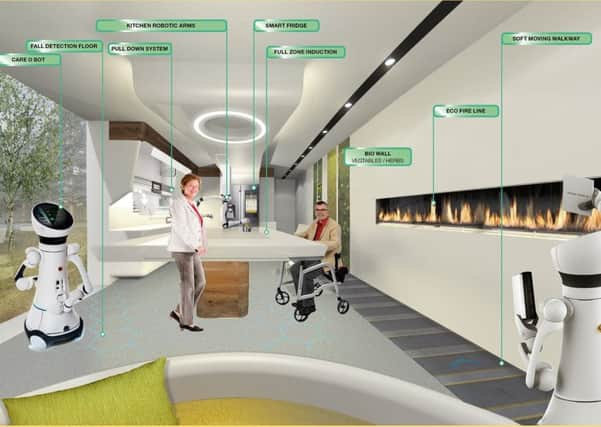Homes for oldies offer a sci-fi solution to staying put


The Office for National Statistics predicts that 29.5 per cent of the population will be over 60 by 2039 and one in 12 will be aged 80 or over. Many in that demographic are wondering what sort of retirement awaits them.
The lack of appropriate property is a major issue now and the International Longevity Centre predicts that by 2030 there will be a shortage of 160,000 homes suitable for older people and by 2050, the gap could grow to 376,000.
Advertisement
Hide AdAdvertisement
Hide AdStill, there is good news thanks to new technology that could help people live independently for longer.
A report commissioned by retirement property builder McCarthy & Stone reveals how gadgets and “almost human” devices could soon transform the lives of tomorrow’s senior citizens.
Neighbourhoods of the Future was compiled by the Agile Ageing Alliance, a campaigning social business committed to accelerating development of innovations that improve health and wellbeing in later life.
It concludes that within the next 20 years, older people are likely to be living in a “cognitive home able to assess and manage individual needs and desires.” It also predicts that we will have access to power suits, robotic assistants, self-stocking fridges, intuitive healthcare and virtual GPs.
Advertisement
Hide AdAdvertisement
Hide AdTracey McDermott, Chief Information Officer at McCarthy & Stone, says the company is analysing the study for ideas on what it could incorporate into its developments.
Ian Spero, founder of the Agile Ageing Alliance, adds: “Some of the ideas covered in our report could be mistaken for science fiction, but they are all based in reality. In the words of science fiction author William Gibson: ‘The future is already here – it’s just not very evenly distributed. If housing providers are willing to listen and act, we can look forward to the growth of a new breed of smarter homes that will enable our older selves to enjoy more meaningful, healthy and creative lives.”
Here are some of the other advances we may be able to look forward to, according to the Neighbourhood of the Future report:
*The home that welcomes, updates and warns you: When we enter our smarter houses and apartments of the future, we’ll expect an update on what’s going on in our home and we’ll be able to share it with those who help us, should we need to. Our fridge will talk to us and tell us when we are about to run out of ingredients. It will also send the shopping list to the online supermarket, if we want it to. A fall detection floor in your home will send an alarm signal to a designated carer if you take a tumble.
Advertisement
Hide AdAdvertisement
Hide AdKeeping agile and domestic support: We could be wearing assistive bodysuits and exoskeletons that will remove the strain of undertaking tasks. Personalised robots could be programmed to do domestic tasks, like the cleaning and bed making. A robotic chef device will prepare meals to any digitally-acquired recipe. Our home may also feature a Soft Moving Walkway, modelled on the principle of an airport travelator, will take us from room-to-room.
Help with health: Poor hearing, sight loss and conditions such as dementia will be supported through sensory-loss technologies that make homes safer. They will help prevent issues, such as cookers being left on, baths overflowing or people becoming confused about their whereabouts. A personal digital assistant may help us to self-diagnose, sparing trips to the GP. Holorportation could allow us to see, hear, and interact with others remotely as if they are present in the same physical space, via the use of 3D cameras.
New energy: The report explores how buildings, constructed with a preinstalled technical membrane, could generate energy. Technology will be able to sense the room temperature, pressure and lighting and adjust it accordingly. We may not need our TV or tablets as programmes could be beamed directly onto our retinas or through special glasses
Co-living: Good inclusive design will help to create flexible spaces that can be adapted in the event that adult children need to care for frail parents.